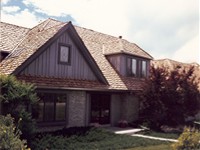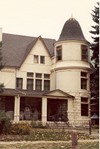Cedar Shakes and Shingles
Cedar Shakes and Shingles are made of natural, renewable resources - trees. Cedar Shakes and Shingles are the most imitated type of roofing material. Manufacturers of Asphalt Shingles, Clay and Concrete Tile, Metal Panels, and most of the Alternative Roofing products all try to duplicate the look and feel of Cedar Shakes and Shingles. They are also the most versatile roof that can be installed with their many different weather exposures, cuts, and installation patterns. See our web page Roofing Guidelines Examples for some information about the proper installation of Cedar Shakes and Shingles.
Wood Shakes and Shingles are available in several grades, fire ratings, lengths, thicknesses, types and two species, cedar and southern pine. The most common type of wood used is cedar. Cedar has a natural resistance to decay and can also be easily split and cut making it the perfect wood for roofing.
Cedar Shakes and Shingles are produced by many saw mills located mainly in Washington, Oregon, and in Canada.
The difference between a shake and a shingle is in how they are cut and in their dimensions.
Shakes
Grade
- Premium Grade (100% Edge Grain, 100% heartwood, 100% clear). Shakes are cut from the very best wood.
- Number 1. (Clear heartwood, maximum 20% flat grain.) They are cut from somewhat less quality wood.
- Number 2. They are cut from lower quality wood or are from rejects of number 1 wood. They will have a larger percentage of flat grain and will have some defects of sapwood, bark, wane, knots, blowouts, maybe some rot, etc. Number 2 wood should really not be used on anything but a barn or shed. Maximum weather exposure is also reduced.
Fire Rating
- Class A
- Class B
- Class C
- Non-Fire Rated
Length
- 18"
- 24"
Butt Thickness
- Minimum 3/8" (Specialty size used only in limited locations) In my opinion, should not be used anywhere. Thankfully is not permitted in most areas.
- Minimum "1/2" for Medium
- Minimum "3/4" for Heavy
- Minimum "1" or more as specified for custom orders, sometimes referred to as Jumbos
Type
- Hand-Split Resawn Shakes are first mechanically or hand split so both surfaces are split wood. They are then run through a band saw diagonally cutting the board into two tapered shakes with one side split and the other sawn. Premium Grade is cut from the best wood while Number 1 is from somewhat less quality wood.
- Tapersawn Shakes are sawn on both sides. They are usually cut out of lower quality wood, but can be out of high quality wood if so specified. Premium Grade is cut from the best wood while Number 1 is from somewhat less quality wood. Number 2 is cut from the wood that is left over and in my opinion is not worth using except on out buildings and barns.
- Tapersplit Shakes are hand split on both sides. They are cut out of the very best edge grain wood.
When specifying Shakes, make sure to state the Grade, Fire Rating, Length, Butt Thickness, Type, and Species. Example: Premium Grade (100% Edge Grain), non-Fire Rated, 24", Heavy, Hand-Split Resawn, Cedar Shakes.
Shingles
Grade
- Number 1. (100% Edge Grain, 100% heartwood, 100% clear) Shingles are cut from the very best wood.
- Number 2. They are cut from somewhat lower quality wood or are from rejects of number 1 wood. The shingles are allowed to have limited sapwood and flat grain but the face of the shingle will have 10", 11", 16" clear with limited knots and defects above the clear area for 16", 18" and 24" shingles respectively.
- Number 3. They are cut from even lower quality wood or are from rejects of number 1 and 2 wood. The shingles are allowed to have unlimited sapwood and flat grain but the face of the shingle will have 6" clear on both 16" and 18" shingles and 10" clear on 24" shingles with limited knots and defects above the clear area. Number 3 wood should really not be used on anything but a barn or shed. They are installed with even less weather exposure.
Fire Rating
- Class A
- Class B
- Class C
- Non-Fire Rated
Length
- 16" Fivex
- 18" Perfection
- 24" Royal
Butt Thickness
- 5 butts equal 2" for Fivex
- 5 butts equal 2 1/4" for Perfections
- 4 butts equal 2" for Royals
Type
There is basically only one type used for roofing and it is simply called a wood shingle. However, there are three sizes that vary in butt thickness and in length. All are cut on both sides using an automated circular saw.
- The Fivex
- Perfection
- Royal
There are also three other styles of wood shingles mainly used for both interior and exterior walls and one is sometimes used on roofs. These are wood shingles that are further cut, grooved, sanded, or even painted to change their appearance either at their butt or face.
When specifying Cedar Shingles make sure to state the Grade, Fire Rating, Type, and Species. Example: Number 1, Class C Fire Rated, Fivex, Cedar Shingles. The type dictates the length and butt thickness of the shingles.
The installed cost of a Cedar Shake and Shingle roof is more expensive compared to most Asphalt Shingles and slightly more expensive than a properly installed Concrete Tile but less than most Clay Tile.
The life expectancy depends a great deal on two things: 1) the better quality wood will last much longer 2) the roof covering must be installed well by a craftsman to get the most life out of the good wood. My old roofing installation company replaced many Cedar Shake roofs that were 35 plus years old. One roof covering in Cherry Hills Village was a Tapersplit Cedar Shake that was originally installed in 1923. The wood and the craftsmanship of installation were unbelievable. We replaced the original roof in 1985 - 62 years later! Of course they chose Cedar Shakes again. We also replaced many Cedar Shingle roofs which were installed over spaced sheathing in Denver that were 40, 50 and 60 years old. Cedar Shakes and Shingles can last a long time if you use the highest quality Cedar and a craftsman in roofing for the installation.
Cedar Shakes and Shingles
- are more expensive compared to most Asphalt Shingles and slightly more expensive than a properly installed Concrete Tile but less than most Clay Tile.
- are one of the most difficult roofing materials to install correctly.
- are fairly easy to cut valleys and around roof protrusions using a circular saw.
- require a great deal of craftsmanship to install correctly. A beginning roofer can be taught to install Cedar Shakes and Shingles properly with supervision in about a year or so but it takes years of experience to be a craftsman at it.
- are a 2 or 3 ply roofing system if Cedar Shakes (depending on weather exposure) and a 3 ply roofing system if Cedar Shingles, meaning that when drilling a hole anywhere through the exposed surface area of the shingle there are one or two layers below that the drill would have to go through before reaching the underlayment.
- have little chance of leaking in the field because of their multiple plies.
- can easily be walked on without damaging the roof.
- are fairly easy to repair.
- should last 20 to 25 years or more depending on the quality of the installation and the wood. In some areas like Colorado can last 40 or more years.
- can be installed as a Class A Fire Rated roof system at additional costs and somewhat less life expectancy.
- are more resistant to damage from hail than most other types of Steep-Roofing materials.
- are more resistant to wind blow off than most other types of Steep-Roofing materials. If installed properly can withstand 160 mph plus winds.
- can be easily installed on small areas and on difficult cut up architectural areas.
- will resist snow sliding off better than most other roofing materials because of the surface adhesion they provide.
- are medium in weight, from about 2 pounds per square foot to just over 3 pounds per square foot depending on how wet they are.
- fade naturally to a grey brown.
- are easily matched. A replaced area or shingle will at first stand out but within a year or so completely blend in.
- come in only one color and shade unless you paint them, which is not recommended.
- can be installed in all temperatures from near 0 to 120 degrees or more.
- are very slippery when wet. Are very dangerous to walk on when wet.




Visit our
Roof Inspection Services
web page
and the many other web
pages throughout this website to find
answers to your roofing questions and
solutions to your roofing problems.
Page Revised/Updated 2/27/2023










